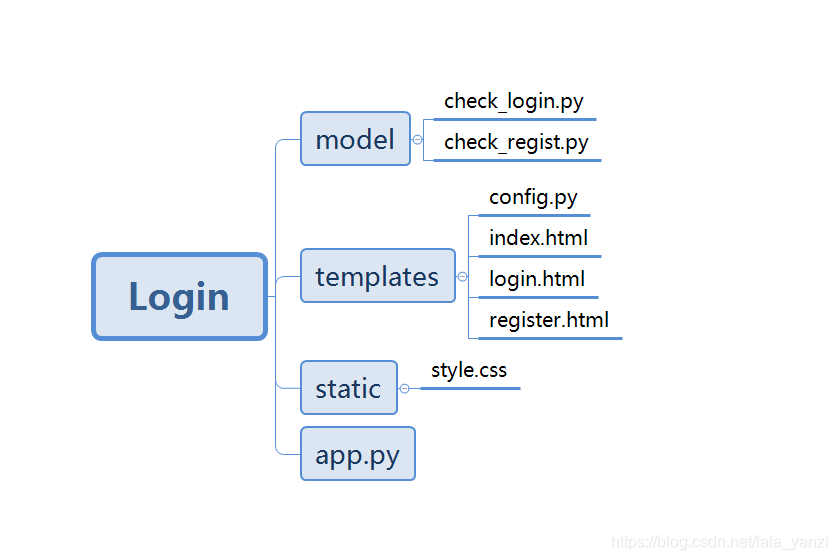本文主要介紹了Flask登錄注冊項目的簡單實現(xiàn)�����,分享給大家���,具體如下:
目錄結(jié)構(gòu)

配置文件設計
/templates/config.py
#數(shù)據(jù)庫連接配置
import pymysql
conn = pymysql.connect(
host='192.XXX.XXX.XX',
port=320xx,
user='root',
password='123456',
database='test_XX'
)
首頁/templates/index.html
!DOCTYPE html>
html lang="en">
head>
meta charset="UTF-8">
{# link rel=stylesheet type=text/css href="{{ url_for('static', filename='style.css') }}" rel="external nofollow" rel="external nofollow" >#}
meta name="viewport" content="width=device-width, initial-scale=1.0">
link rel="stylesheet" type="text/css" href="/static/style.css" rel="external nofollow" rel="external nofollow" rel="external nofollow" >
title>林家小豬測試小站/title>
/head>
body>
div>
h1>您好����,{{ username }}�,歡迎來到我的小站/h1>
a href="{{ url_for('user_login') }}" rel="external nofollow" rel="external nofollow" >退出/a>
br/>
/div>
/body>
/html>
登錄頁面/templates/login.html
!DOCTYPE html>
html lang="en">
head>
meta charset="UTF-8">
meta name="viewport" content="width=device-width, initial-scale=1.0">
link rel="stylesheet" type="text/css" href="/static/style.css" rel="external nofollow" rel="external nofollow" rel="external nofollow" >
{# link rel="stylesheet" href="{{ url_for('static', filename='style.css') }}" rel="external nofollow" rel="external nofollow" type="text/css">#}
title>登錄/title>
/head>
body>
div>
h1>用戶登錄/h1>
!--將登陸信息放到一個form中-->
form method="POST">
input type="text" name="username" placeholder="請輸入用戶名" />
br/>
input type="password" name="password" placeholder="請輸入密碼(小于12位)" />
br/>
!--jinja2的函數(shù)-->
{% if message %} {{message}} {% endif %}
br/>
input type="submit" value="登錄" />
input type="reset" value="重置" />
!--跳轉(zhuǎn)到register的頁面-->
a href="{{ url_for('register') }}" rel="external nofollow" >注冊/a>
/form>
/div>
/body>
/html>
注冊頁面/templates/register.html
!DOCTYPE html>
html lang="en">
head>
meta charset="UTF-8">
meta name="viewport" content="width=device-width, initial-scale=1.0">
link rel="stylesheet" type="text/css" href="/static/style.css" rel="external nofollow" rel="external nofollow" rel="external nofollow" >
title>注冊/title>
/head>
body>
div>
h1>用戶注冊/h1>
form method="POST">
input type="text" name="username" placeholder="請輸入用戶名" />
br/>
input type="password" name="password" placeholder="請輸入密碼(小于12位)" />
br/>
!--jinja2的函數(shù)-->
{% if message %} {{message}} {% endif %}
br/>
input type="submit" value="注冊" />
input type="reset" value="重置" />
a href="{{ url_for('user_login') }}" rel="external nofollow" rel="external nofollow" >登錄/a>
/form>
/div>
/body>
/html>
登錄校驗 /model/check_login.py
from templates.config import conn
cur = conn.cursor()
def is_null(username,password):
if(username==''or password==''):
return True
else:
return False
def is_existed(username,password):
sql="SELECT * FROM user WHERE username ='%s' and password ='%s'" %(username,password)
cur.execute(sql)
result = cur.fetchall()
if (len(result) == 0):
return False
else:
return True
def exist_user(username):
sql = "SELECT * FROM user WHERE username ='%s'" % (username)
cur.execute(sql)
result = cur.fetchall()
if (len(result) == 0):
return False
else:
return True
注冊校驗 /model/regist_login.py
from templates.config import conn
cur = conn.cursor()
def add_user(username, password):
# sql commands
sql = "INSERT INTO user(username, password) VALUES ('%s','%s')" %(username, password)
# execute(sql)
cur.execute(sql)
# commit
conn.commit() # 對數(shù)據(jù)庫內(nèi)容有改變,需要commit()
conn.close()
最后編輯運行文件
app.py
from flask import Flask,render_template
from flask import redirect
from flask import url_for
from flask import request
from model.check_login import is_existed,exist_user,is_null
from model.check_regist import add_user
app = Flask(__name__)
@app.route('/')
def index():
return redirect( url_for('user_login') )
@app.route('/user_login',methods=['GET','POST'])
def user_login():
if request.method=='POST': # 注冊發(fā)送的請求為POST請求
username = request.form['username']
password = request.form['password']
if is_null(username,password):
login_massage = "溫馨提示:賬號和密碼是必填"
return render_template('login.html', message=login_massage)
elif is_existed(username, password):
return render_template('index.html', username=username)
elif exist_user(username):
login_massage = "提示:密碼錯誤�����,請輸入正確密碼"
return render_template('login.html', message=login_massage)
else:
login_massage = "不存在該用戶"
return render_template('login.html', message=login_massage)
return render_template('login.html')
@app.route("/regiser",methods=["GET", 'POST'])
def register():
if request.method == 'POST':
username = request.form['username']
password = request.form['password']
if is_null(username,password):
login_massage = "溫馨提示:賬號和密碼是必填"
return render_template('register.html', message=login_massage)
elif exist_user(username):
return redirect(url_for('user_login'))
else:
add_user(request.form['username'], request.form['password'] )
return render_template('index.html', username=username)
return render_template('register.html')
if __name__=="__main__":
app.run()
到此這篇關(guān)于Flask登錄注冊項目的簡單實現(xiàn)的文章就介紹到這了,更多相關(guān)Flask登錄注冊內(nèi)容請搜索腳本之家以前的文章或繼續(xù)瀏覽下面的相關(guān)文章希望大家以后多多支持腳本之家��!
您可能感興趣的文章:- Python的Flask框架中實現(xiàn)簡單的登錄功能的教程
- Flask框架通過Flask_login實現(xiàn)用戶登錄功能示例
- 使用Python的Flask框架表單插件Flask-WTF實現(xiàn)Web登錄驗證
- flask使用session保存登錄狀態(tài)及攔截未登錄請求代碼
- Flask框架的學習指南之用戶登錄管理
- python之Flask實現(xiàn)簡單登錄功能的示例代碼
- python+flask編寫一個簡單的登錄接口